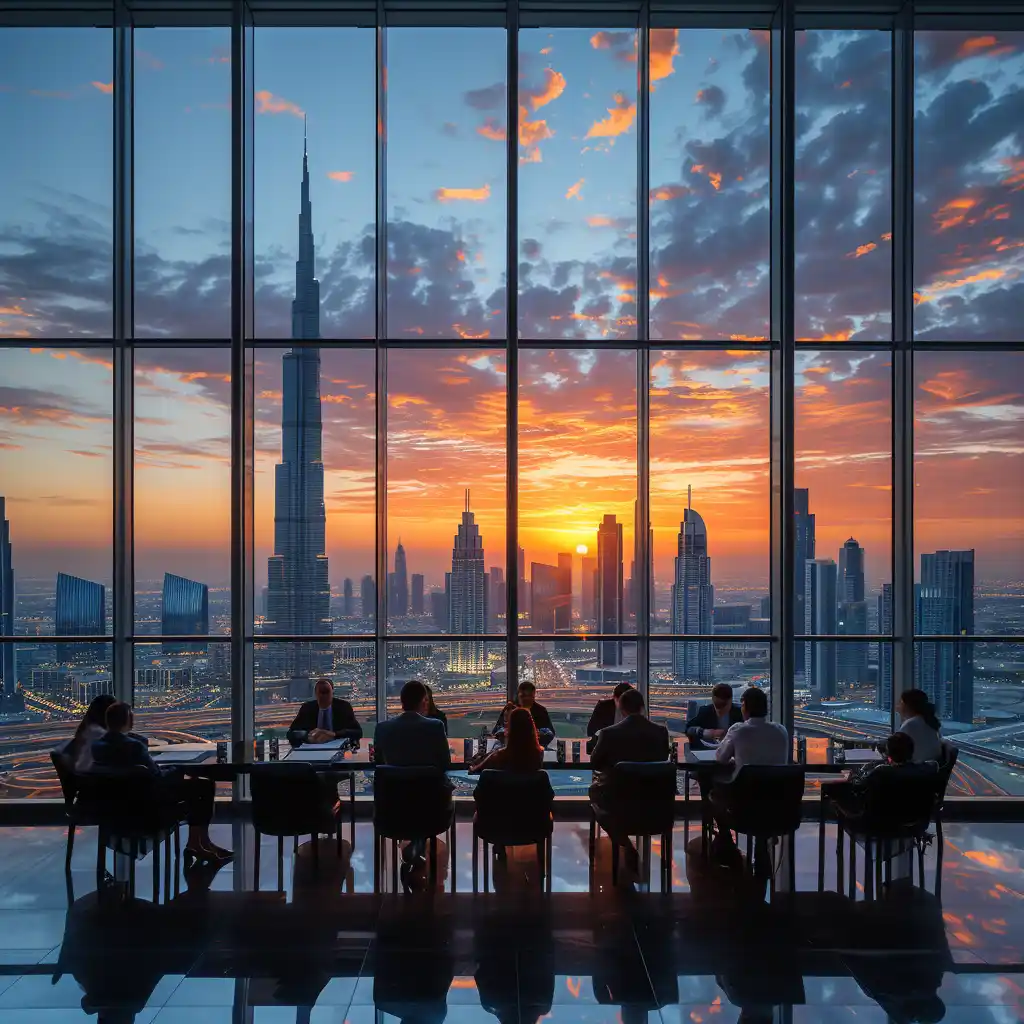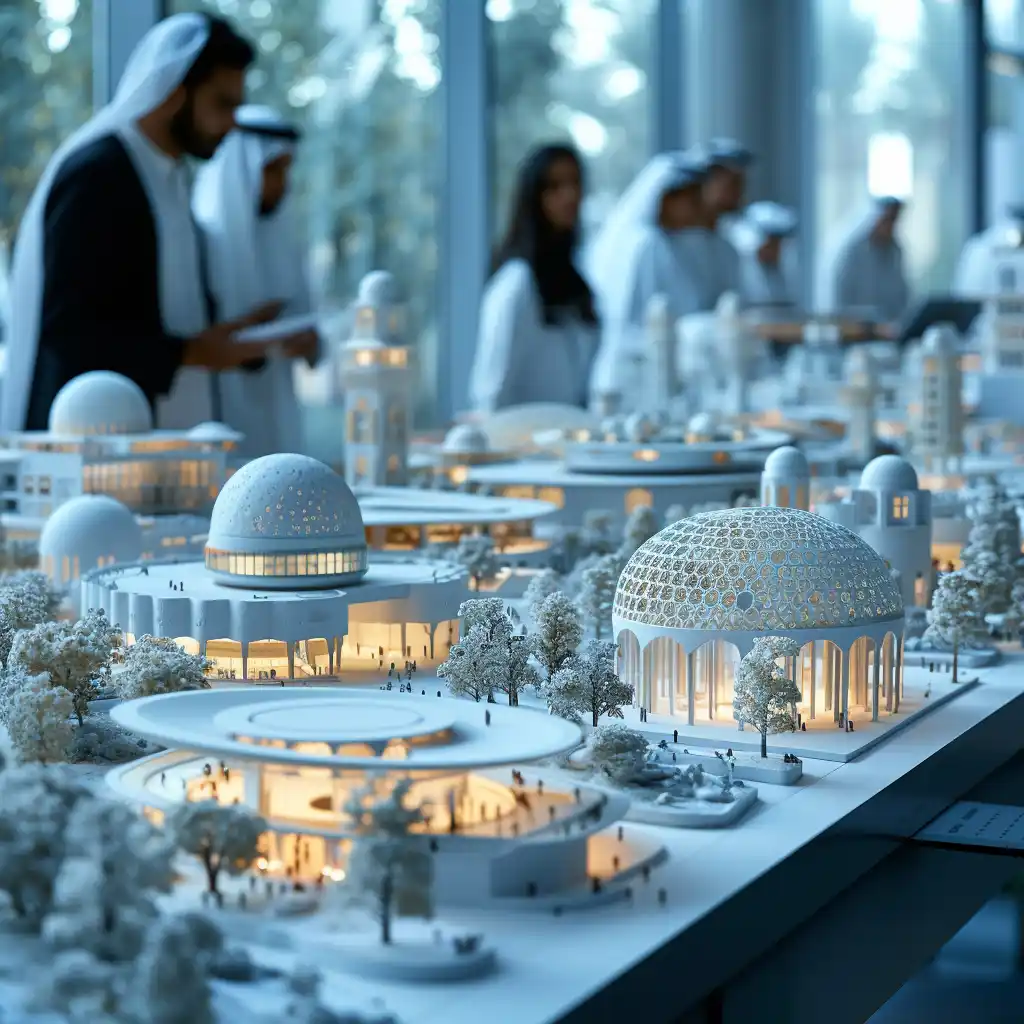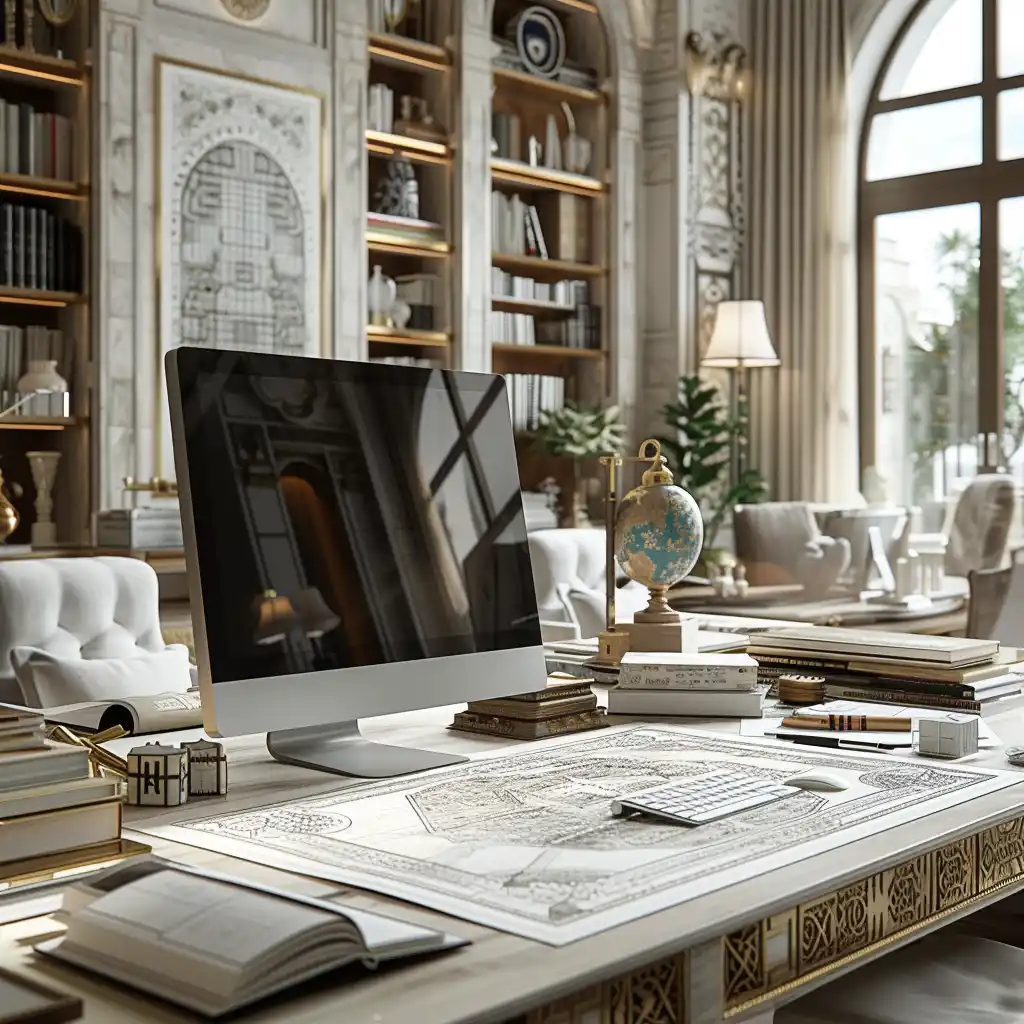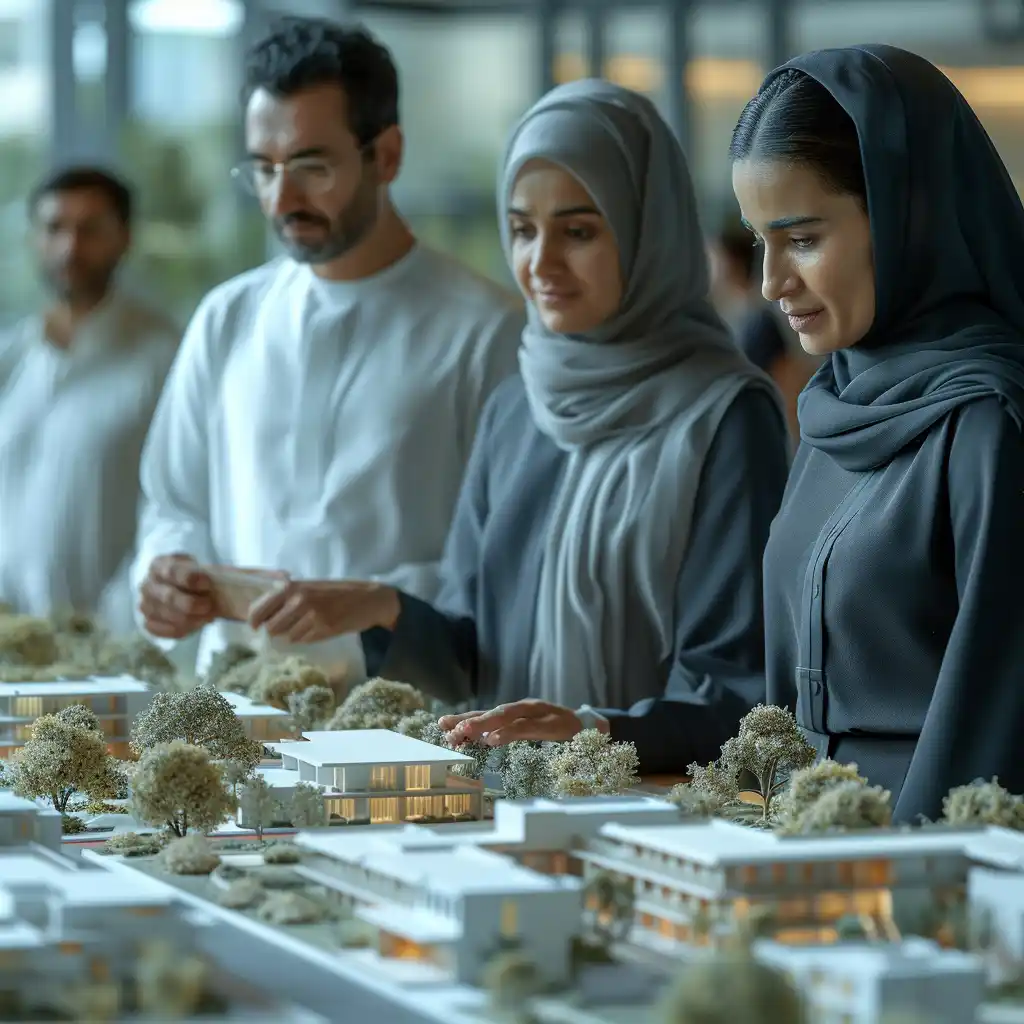In the heart of the Middle East, Dubai stands as a testament to human ingenuity and architectural ambition. This city, known for its skyline that pierces the heavens, luxurious lifestyles, and a hub for global business, serves as a canvas for architects and designers who dare to dream big.
The Armanipro Architecture Group, with its commitment to excellence and innovation, takes center stage in this narrative of creation and transformation. Today, we delve into the intricate world of Architectural Design and Calculations in Dubai, where precision meets beauty, and functionality intertwines with aesthetic appeal.
Our journey through this article is designed to illuminate the path for those who aspire to leave their mark on Dubai’s architectural landscape, whether through majestic skyscrapers, innovative commercial spaces, or serene residential havens.
Visit our services
For those inspired by Dubai’s architectural marvels and looking to embark on their projects in this vibrant city, the Armanipro Architecture Group invites you to bring your visions to life with us.
We explore not just the ‘what’ and ‘how’ but also the ‘why’ behind architectural marvels that define Dubai’s skyline. From the initial sketches to the final touches of interior decoration, every step is a calculated dance of creativity, engineering, and environmental sustainability.
The architecture and interior design scene in Dubai is not just about creating spaces; it’s about crafting experiences that resonate with people, embodying a blend of cultural heritage and futuristic vision. As experts in the field, the Armanipro Architecture Group brings a wealth of knowledge and experience, guiding projects from conception to realization with precision and flair.
To read more: The Art of Opulence: Ultra Luxury Interior Design in Dubai’s Architectural Landscape
This article aims to be a comprehensive guide for those involved in the real estate construction and renovation market, offering insights into project execution, design planning, and integrating technology in interior engineering.
Dubai’s real estate market is dynamic and competitive, offering immense opportunities for innovation and growth. Whether you are a developer, investor, or designer, understanding the nuances of Architectural Design and Calculations in Dubai is crucial.
This article is not just a narrative; it’s a roadmap to success in one of the most vibrant architectural arenas in the world. Join us as we explore the principles, processes, and practices that make Dubai a global architectural powerhouse.
As we unfold the layers of design, execution, and implementation in the following sections, keep an eye out for visual cues and insights that can transform a mere space into a masterpiece. For those moments where words fall short, we’ll let images speak, providing a glimpse into the possibilities that await Dubai’s architectural future.
Project Execution in Dubai
Embarking on an architectural project in Dubai, a city that defies the ordinary and champions the extraordinary, requires a meticulous approach to project execution. This section unravels the complexity of bringing architectural visions to life in Dubai, from the drawing board to the skyline, focusing on best practices, the importance of adept project management, and learning from the successes of iconic projects within this bustling metropolis.
Overview of Project Execution in Dubai
Dubai’s architectural landscape is a testament to human ambition, where each project, whether a towering skyscraper or a sprawling residential complex, begins with a vision. Project execution in this context is not merely about adherence to timelines and budgets; it’s about realizing architectural marvels that stand the test of time.
To read more: Sculpting the Desert: Dubai’s Top Landscape Architecture
The process is intricate, involving numerous stakeholders, including architects, engineers, contractors, and clients, all working in unison to transform a concept into concrete reality. The city’s regulatory framework, highlighted by the Dubai Building, ensures that all projects not only meet global standards but also reflect the local culture and environmental considerations.
Navigating this framework requires a deep understanding of local regulations, an aspect that the Armanipro Architecture Group, with its extensive experience in the region, navigates with expertise and finesse.
Project Management Best Practices
Project management is the backbone of successful architectural execution. It’s an art and science that ensures projects are delivered on time, within budget, and to the desired quality. Best practices in project management involve thorough planning, stakeholder engagement, risk management, and technology integration.
One of the key aspects of project management in Dubai’s architectural sector is adaptability. The city’s fast-paced development and evolving regulations demand that project managers be flexible yet precise in their planning and execution strategies.
Leveraging technology, such as Building Information Modeling (BIM), aids in visualizing architectural projects in 3D, allowing for better decision-making, more accurate cost estimations, and efficient project execution.
Case Studies of Successful Projects in Dubai
Dubai is home to some of the world’s most iconic architectural projects, each with its own story of challenges, innovation, and triumph. A notable example is the Burj Al Arab, a symbol of luxury and a testament to the ingenuity of architectural design and calculations in Dubai.
The project’s execution involved groundbreaking engineering techniques and meticulous project management, resulting in a structure that has become synonymous with Dubai’s identity.
Analyzing such case studies offers practical insights into the complexities of project execution in Dubai. It reveals the importance of innovative solutions, the integration of sustainable practices, and the value of effective communication among all project stakeholders. These projects not only showcase architectural excellence but also serve as benchmarks for future endeavors in the city
This section on project execution in Dubai provides a foundational understanding of the meticulous approach required to bring architectural visions to life in this dynamic city. The Armanipro Architecture Group, with its deep-rooted expertise and commitment to excellence, stands at the forefront of transforming Dubai’s architectural dreams into reality.
As we move forward, the principles and practices discussed here will illuminate the path for future projects, ensuring they are not only feasible but also reflective of Dubai’s ambitious spirit.

Architectural Design and Calculations in Dubai
In the heart of the United Arab Emirates, Dubai stands as a beacon of architectural innovation and excellence. The city’s skyline, a picturesque canvas of modernity, showcases the intricate balance between aesthetic appeal and structural integrity.
This balance is achieved through meticulous architectural design and precise calculations, ensuring that each building not only adds to Dubai’s visual narrative but also adheres to the highest standards of safety and sustainability.
In this section, we explore the core aspects of architectural design and calculations in Dubai, guided by the city’s building code and regulations, design principles, and the specific requirements that shape the architectural landscape of this dynamic city.
Dubai Building Code and Regulations
Dubai’s architectural feats are underpinned by a comprehensive set of building codes and regulations, designed to ensure the safety, sustainability, and aesthetic quality of its structures. The Dubai Building Code serves as a critical reference for architects and builders, outlining the standards for construction practices and materials, environmental considerations, and energy efficiency.
Navigating these regulations requires a deep understanding of their implications on architectural design and the calculation methodologies used to comply with them. The code emphasizes the importance of sustainable design practices, encouraging the integration of green building materials and technologies to minimize environmental impact.
For architects working in Dubai, familiarity with these regulations is not just a legal requirement but a cornerstone of responsible and innovative architectural practice.
Architectural Design Principles
The architectural design process in Dubai is a complex interplay of creativity, functionality, and compliance. Architects must balance their visionary ideas with the practical realities of construction, all while adhering to the city’s strict building codes.
This balance is achieved through a set of guiding principles that emphasize aesthetic beauty, structural integrity, and environmental sustainability.
To read more: The Artistic Genius of Famous Interior Designer Through an Architect’s Lens
One of the key principles is the integration of cultural elements into modern designs, reflecting Dubai’s rich heritage and cosmopolitan spirit. Another is the commitment to innovation, as seen in the city’s willingness to embrace and pioneer new building technologies and materials.
These principles guide the architectural design process from concept to completion, ensuring that each project contributes to the city’s reputation as a global architectural marvel.
Calculations and Requirements for Architectural Projects
The architectural marvels of Dubai are not just a product of creative design but also rigorous calculations. These calculations cover a wide range of considerations, from structural integrity and wind resistance to energy efficiency and material sustainability. Architects and engineers use advanced software tools to model and simulate the performance of their designs, ensuring they meet Dubai’s stringent safety and sustainability criteria.
The calculation process is integral to the project’s lifecycle, influencing decisions on materials, construction techniques, and even the building’s orientation to optimize natural light and heat. The Dubai Building Code provides a framework for these calculations, setting the standards for load-bearing capacities, fire resistance, and more.
This meticulous approach to architectural design and calculations ensures that each building is not only a visual masterpiece but also a safe, sustainable, and functional space that meets the needs of its occupants and the wider community.
As we delve into the world of Architectural Design and Calculations in Dubai, it becomes clear that the city’s architectural achievements are the result of a harmonious blend of art and science. The Armanipro Architecture Group embodies this blend, leveraging its expertise to create spaces that are innovative, sustainable, and true to the spirit of Dubai.
The principles and practices outlined in this section are not just guidelines but the foundation upon which the city’s architectural legacy is built.

Interior Engineering in Dubai
The realm of interior engineering in Dubai is a fascinating intersection of art, technology, and functionality. This discipline goes beyond mere aesthetic considerations, diving deep into the technical aspects that make interior spaces both beautiful and livable.
In Dubai, where luxury and innovation are paramount, interior engineering plays a crucial role in creating spaces that are not only visually stunning but also ergonomically sound and environmentally sustainable. This section delves into the significance of interior engineering in Dubai, the integration of technology in this field, and showcases examples of innovative projects that set new standards for interior spaces.
Importance of Interior Engineering in Dubai
In Dubai, a city known for its architectural wonders and cutting-edge designs, interior engineering is not just an afterthought—it’s an integral part of the architectural process.
This discipline ensures that the interiors of buildings meet the high standards of comfort, safety, and sustainability that Dubai is known for. Interior engineers work closely with architects and designers to create spaces that are aesthetically pleasing, functionally efficient, and environmentally friendly.
To read more: Elevating Elegance: The Art of Luxury Renovations Dubai
The importance of interior engineering in Dubai also stems from the city’s diverse cultural landscape and the need for spaces that reflect a wide range of tastes and preferences.
From luxury hotels to commercial spaces and residential buildings, interior engineering ensures that every detail, from lighting to acoustics to air quality, is meticulously planned and executed.
Integration of Technology in Interior Engineering
Technology plays a pivotal role in the field of interior engineering, especially in a forward-thinking city like Dubai. Advanced software and tools allow engineers and designers to create detailed 3D models, simulate environmental conditions, and test the functionality of interior spaces before they are built.
This integration of technology enhances the precision of design calculations, ensures compliance with building codes, and facilitates the creation of innovative solutions to complex design challenges.
Moreover, the use of smart technology and automation in interior engineering is becoming increasingly common in Dubai. From smart lighting systems that adjust based on the time of day to advanced HVAC systems that optimize energy consumption, technology is used to create interiors that are not only luxurious but also intelligent and sustainable.

Design Planning in Dubai
In the vibrant city of Dubai, where architectural wonders dot the skyline, design planning stands as a pivotal phase in the creation of these marvels. It is a meticulous process that bridges visionary concepts with tangible realities, ensuring that every structure not only contributes to the aesthetics of the city but also adheres to its stringent standards of functionality and sustainability.
This section explores the significance of design planning in Dubai, the steps involved in the design planning process, and the role it plays in the successful completion of architectural projects.
Significance of Design Planning in Dubai
Design planning in Dubai is more than just an initial step in the architectural process; it’s a comprehensive strategy that encompasses the assessment of feasibility, environmental impact, and regulatory compliance.
This phase is crucial for setting the foundation of a project that is ambitious yet achievable, innovative yet sustainable. In a city that aspires to be a global benchmark for architectural excellence, design planning ensures that each project aligns with Dubai’s vision for its future, integrating cutting-edge technologies and sustainable practices from the outset.
Moreover, design planning addresses the unique challenges and opportunities presented by Dubai’s geographic and cultural context, incorporating local materials, climate considerations, and cultural significance into the designs. This thoughtful approach to planning facilitates the creation of spaces that are not only functional and beautiful but also deeply rooted in the local context.
Steps in the Design Planning Process
The design planning process in Dubai is a structured approach that involves several key steps, each contributing to the project’s overall success. It begins with a thorough site analysis, understanding the physical and regulatory landscape to identify opportunities and constraints.
Following this, concept development translates the project’s objectives and requirements into initial design proposals, which are then refined through feedback and further analysis.
Detailed planning and documentation form the next phase, where technical specifications, materials, and construction techniques are defined. This stage is critical for ensuring that the project complies with the Dubai Building Code and other relevant regulations.
Finally, the planning process includes obtaining the necessary approvals from local authorities, a step facilitated by the Dubai Development Authority Preliminary Design Approval Guide, which outlines the requirements for preliminary design submissions.
Role of Design Planning in Successful Projects
The role of design planning in the success of architectural projects in Dubai cannot be overstated. This phase not only sets the direction for the project but also identifies potential challenges early on, allowing for solutions to be integrated into the design before construction begins.
Effective design planning results in projects that are aesthetically pleasing, functionally efficient, and environmentally responsible.
Additionally, design planning is essential for managing stakeholders’ expectations, ensuring that the final product aligns with the vision and requirements of clients, investors, and the community. It serves as a communication tool, presenting a clear and cohesive plan that guides all parties through the project’s lifecycle.

Conclusion
As we draw our exploration to a close, the journey through the architectural and interior design landscape of Dubai has unveiled the meticulous, innovative, and ambitious approach that defines this city’s built environment.
From the foundational phase of project execution to the detailed intricacies of design planning, it becomes evident that Dubai is not just building structures; it’s crafting the future of urban living.
Each phase, be it the rigorous architectural design and calculations or the cutting-edge interior engineering practices, reflects a commitment to excellence, sustainability, and innovation that the Armanipro Architecture Group embodies and champions in every project.
Dubai’s architectural achievements are a testament to the city’s vision, a blend of cultural heritage and futuristic aspirations. This vision is brought to life through the dedication and expertise of architects, designers, engineers, and planners who navigate the challenges and opportunities presented by one of the world’s most dynamic urban landscapes.
The insights shared in this article aim to illuminate the path for future projects in Dubai and beyond, showcasing the principles, practices, and technologies that will continue to shape the world of architecture and interior design.
In conclusion, the architectural and interior design scene in Dubai stands as a beacon for the global community, a source of inspiration and innovation that pushes the boundaries of what is possible.
The Armanipro Architecture Group remains at the forefront of this journey, leveraging its deep-rooted expertise to create spaces that are not just visually stunning but also environmentally responsible and deeply connected to the human experience.
Recourses and Related Links: